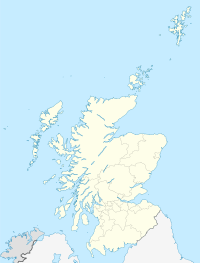Action off Lerwick
| Action off Lerwick | |||||||
|---|---|---|---|---|---|---|---|
| Part of World War I | |||||||
 Gun from SMS Bremse at Scapa Flow | |||||||
| |||||||
| Belligerents | |||||||
|
|
| ||||||
| Commanders and leaders | |||||||
|
|
| ||||||
| Strength | |||||||
|
2 destroyers 2 naval trawlers | 2 light cruisers | ||||||
| Casualties and losses | |||||||
|
~300 killed or wounded 2 destroyers sunk | None | ||||||
| The British were escorting twelve merchant ships during the battle, nine were sunk. | |||||||
Lerwick, main port of the Shetland Islands | |||||||
The Action off Lerwick was a small naval battle of 1917 fought in the North Sea during the First World War. Two German light cruisers attacked a convoy of coal-carrying ships and their escort. In the course of the battle, the two escorting destroyers and nine neutral Scandinavian ships were sunk off Shetland, Scotland.
Background
The British regularly shipped coal across the North Sea from Norway in 1917; these convoys were lightly defended so the Kaiserliche Marine took advantage of the situation. At first, submarines were deployed to sink the merchantmen, but after these attacks failed the German Admiral Reinhard Scheer ordered an attack with surface combatants. U-boats informed Admiral Scheer that a fleet of nine Scandinavian, one Belgian and two British steamers laden with coal were headed west from Lerwick. The two light cruisers Brummer and Bremse—each armed with four 5.9 in (150 mm) naval guns and two 3.5 in (89 mm) anti-aircraft guns—were designated to ambush to convoy which was found on 17 October, 65 mi (56 nmi; 105 km) off Lerwick. They were adapted to appear as British vessels.[1] Over 600 officers and men made up the crews of the two warships.[2][3] Escorting the convoy was two British destroyers, Mary Rose and Strongbow with two naval trawlers, HMS Elise and P. Fannon. The destroyers had complements of about 80 men and armament of three 4 in (100 mm) guns, three 2-pounders and two 21 in (530 mm) torpedo tubes. British Lieutenant Commander Charles Fox led the Allies convoy in his flagship Mary Rose, Lieutenant Commander Edward Brooke skippered Strongbow.[2][3]
Action
At about 06:00, lookouts on Strongbow spotted the two German light cruisers approaching their ship at a distance of over 4,000 yd (3,700 m) away. They were mistaken for British cruisers and signaled to identify themselves but no response was received. The Germans mistook the destroyers for cruisers themselves, and they began signaling the British to come out and fight. Eventually the range closed to within 3,000 yd (2,700 m) so the German ships opened fire with their 5.9-inch guns. Immediately after, the two destroyers turned for an attack and opened up with their 4-inch guns, followed by Elise while P. Fannon was ordered to continue west with the convoy. HMS Strongbow was struck first, shells damaged her main steam pipe and others knocked out her radio communications just as the radioman was attempting to raise the alarm.[2][3]
After a few more minutes of firing, Strongbow was heavily damaged so the Germans turned their attention to Mary Rose and quickly sank her. The Germans then opened fire on Strongbow again and damaged her further while Elise was maneuvering to rescue Strongbow′s crew. Elise opened fire and her shots missed but she drew German fire which was now being concentrated on the merchant ships. Both of the light cruisers fired on Elise and forced her to flee out of range. The convoy was then attacked again and all nine of the Scandinavian vessels were sunk. All together, about 250 Allies and Scandinavians were killed, at least 50 others were wounded. Lieutenant Commander Fox was killed along with about 70 others from Mary Rose, only two officers and eight enlisted men survived. Strongbow lost half of her complement, four officers and 44 men were rescued, she sank hours later at around 09:30. German forces were accused of shelling survivors in the water but they later denied the accusation.[4][2][3]
Aftermath
When the action was over the German ships returned to base without damage or loss of life.[1] Other British naval forces in the area did not receive news of the engagement until almost 16:00, so Brummer and Bremse could not be intercepted. The event was regarded as an outrage by the Allies who protested that the attack on neutral ships was illegal and that the Germans gave the crews of the merchant vessels no time to evacuate, thus resulting in a large loss of civilian lives. Both of the British destroyer commanders received credit for bravery though some members of the Admiralty felt that by leaving the convoy to engage a superior enemy force, they left the merchant steamers open to attack.[2][3]
Order of Battle
Royal Navy
HMS Mary Rose, destroyer, flagship
HMS Strongbow, destroyer
HMS Elise, naval trawler
HMS P. Fannon, naval trawler
Kaiserliche Marine
SMS Bremse, light cruiser, flagship
SMS Brummer, light cruiser
References
- ^ a b Clemmessen, Michael H; Faulkner, Marcus S; (2013) Northern European Overture to War, 1939-1941: From Memel to Barbarossa pp. 314
- ^ a b c d e http://www.gwpda.org/naval/maryrose.htm
- ^ a b c d e "Archived copy". Archived from the original on 2011-02-28. Retrieved 2010-12-11.
{{cite web}}: Unknown parameter|deadurl=ignored (|url-status=suggested) (help)CS1 maint: archived copy as title (link) - ^ http://www.navweaps.com/index_oob/OOB_WWI/OOB_WWI_Norwegian-Raid.htm

